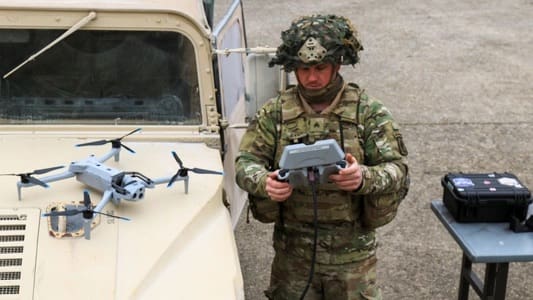If you’ve hung around with me over the last year all I want to talk about is attritable drones and you’ve likely heard me say “The attritable drone is the 155 shell of the future” so many times you’d like to rip off my arm and beat me to death. But right now I’m so happy that I don’t think I’d feel it.
Fortunately, I’m not the only person who thinks this way. The Marines have set up a drone team to work on requirements and TTPs and now the Army is jumping on board with First Person View (FPV) attritable drones.
To be sure, the Army (and all of DoD) have procured a lot of unmanned aerial systems but they’ve been what I refer to as “enduring capabilities”. Expensive and exquisite, we can’t afford to lose the vast majority of these systems due to cost and lack of industrial base capacity.
Ukraine on the other hand goes through around 10,000 attritable drones per month, using them as much as munitions as anything. Surging up to 30,000 per month, they are manufactured in small buildings and basements, often near the front.
The vast majority are sent on one-way missions to conduct ISR or deliver end effects like EW and kinetic strike. They allow the small unit commander to have his own dedicated Air Force and it’s changing the way we will fight. I’ve heard some executives in the defense industry look at the lessons learned from drone use in Ukraine and retort with “that’s not how we do it in the US,” demanding that the military continue to buy expensive drones packed with capabilities that will likely be destroyed in their first use. Fortunately, Soldiers and their leaders are seeing the issue and understand that it doesn’t make sense to destroy and bunker with a $50,000 drone when it can be done with a $2000 model. They know that our foes are going to be able to continue to generate these systems even when our exquisite systems are used up in the first days of a large scale conflict. Small, FPV drones provide an asymmetric advantage to even the smallest and least sophisticated of foes.
My vision is a drone categorized as a munition in order to acknowledge its attritable status and to streamline acquisition which ordered in quantity and shoes up at the unit where it is configured using Modular Open Source Architecture (MOSA) components for the day’s operations. Some may be configured with cameras and sensors while others receive effectors such as EW packages and explosive warheads or weapon racks to drop small munitions such as grenades like a mini-bomber. Taking a note from what we’ve seen in Ukraine a flying Claymore may also be an option. Using simple onboard computers and software defined radios, software will be uploaded to provide various flight and command and control enhancements like pixel lock and home on jam capabilities as well as follow the leader control for swarms.
Now on to what the Army is looking at. The other day the Army’s Uncrewed Aircraft Systems Project Office issued a Sources Sought Notice to industry for Purpose Built Attritable Systems (PBAS) First Person View (FPV) Small Uncrewed Aircraft Systems (SUAS).
This Sources Sought is to assess commercially available and viable Purpose-Built Attritable Systems (PBAS) First Person View (FPV) Small Uncrewed Aircraft System (SUAS) candidates for a possible invitation for a follow-on demonstration in support of the United States Army Maneuver Elements. This sources sought may be used to fulfill future procurement requirements.
The Program Executive Office (PEO) Aviation, Project Manager (PM), UAS, seeks information on commercially available products that are production ready, reusable, unretrievable components (uncrewed aircraft platforms, payloads, and ancillary equipment) and cost-effective SUAS to be employed at the maneuver small unit level. FPV enabled SUAS provide the maneuver force a low cost solution with increased maneuverability, precise lethal payload delivery, and operator concealability. As such, the PBAS FPV, hereafter referred to as PBAS, designed with baseline mission characteristics that focus on rapid reconfigurability and modular payload capabilities that allow for mission changes across target acquisition tasks, with the added flexibility to execute kinetic operations as needed. The system’s mission characteristics include a field-level reconfigurable, modular payload capability to execute the primary mission of Reconnaissance Surveillance and Target Acquisition (RSTA), secondary mission of communications relay, and enhanced mission set of lethal payload delivery and electronic support.
What is most critical to this plan, and as far as I know still unavailable, is the Interface Control Document for these MOSA drones. It will tell industry what connectors to use and what power they will have available.
Additionally, we need a domestic supply chain for the components to create these drones. Right now, most batteries, circuitry, and motors are coming from within the Chinese sphere of influence. The alternative suppliers are foreign.
Interested parties should visit sam.gov and have until May 8, 2025, 4:00 PM CST to submit. I’m sure they mean CDT, but then notice says CST.
The image at the top was taken by SPC Israel Fernandez and depicts U.S. Army Sgt. Tucker Smith with the UAS Platoon, 1st Squadron, 91st Cavalry Regiment, 173rd Airborne Brigade prepares his Skydio X10D drone for its observation flight during “Project Shiv” at Grafenwoehr Training Area, Germany, Feb. 20, 2025. Project Shiv is an innovative exercise involving using first person view drones assembled at Balli Airfield in conjunction with development munitions created by the U.S. Army Combat Capabilities Development Command (DEVCOM) Armaments Center. This is the kind of innovation that is going to keep the Army relevant.




